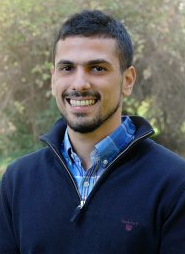Marios Zacharias, a computational physicist looking to improve solar cells efficiency

Dr Marios Zacharias is a computational physicist working on materials modelisation at the FOTON Institute at Université de Rennes.
[BIENVENÜE team]: Hello Marios, what is your background?
[Dr Marios Zacharias] I am interested in materials that can absorb solar energy and convert it into electricity. I come from Cyprus, a very sunny island. There is a good amount of solar production all year long, similar to several countries in Europe, and that’s where I wanted to contribute to with my research.
As a computational physicist, I am developing mathematical/physical theories and develop numerical algorithms that describe material properties. Then, I run calculations to make the first observations. Then, colleagues can use my work to choose which experimentations to make. During my PhD at the University of Oxford, I developed a new methodology for including the effect of temperature in materials calculations. This effect has an important impact on the optical absorption of solar cells.
What is the ULTRA-PK project about?
I am working on solar cell materials, which are the units that are turning solar energy into electricity. Common ones are made of silicon. New materials are emerging today, which may have a lower cost and better properties. With the ULTRA-PK project, I will look for alternative materials, falling into the metal halide perovskite class materials. These materials are built with layers separated by molecules, which control the energy flows. Machine learning has predicted that there are more than 500 possibilities to assemble these layers. My goal is to develop a new approach to investigate the most promising ones and explore their properties that determine power conversion efficiencies. That will help my experimental colleagues to optimize their functions in the lab.
This work will also serve at a fundamental level to better understand quantum mechanics, which more broadly will help to improve solar energy conversion efficiencies. This is a real key issue on the French and European levels. Policies to tackle climate change aim to have net zero emissions and a low carbon economy by 2050. There is also a new urgent need due to the current global energy crisis, stemming from the aftermath of COVID-19, this summer’s prolonged heatwave and the Russia-Ukraine war.
Why did you choose to implement this project at FOTON?
The group where I am working has great expertise in describing solar cell properties, where I hope to be further trained. Also, Jacky Even, my supervisor, is a well-known expert in the field, especially for sunlight conversion from perovskite materials. I hope to receive good direction for the next step of my career while working with him.
Do you have a recommendation to the reader eager to know more?
Have a look at this article on perovskites from the MIT.
Thank you Marios!
Follow Marios on Twitter
